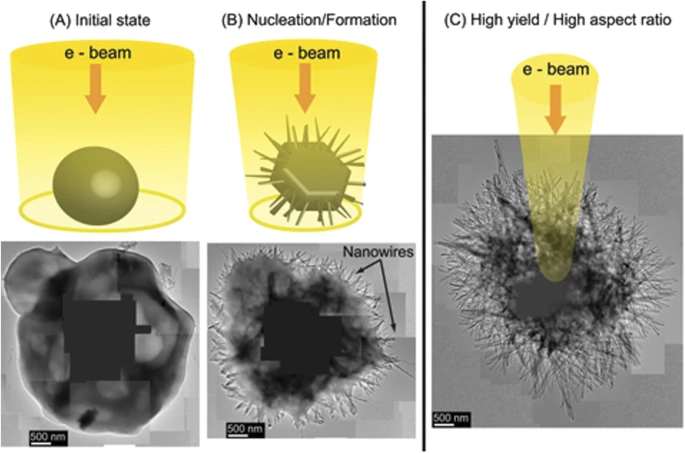The catalyst-assisted nucleation and growth mechanisms for many kinds of nanowires and nanotubes are pretty well understood. At times, though, 1D nanostructures form without a catalyst and the argued growth modes have inconsistencies. One such example is the catalyst-free growth of aluminium borate nanowires. Here we develop an in-situ catalyst-free room temperature growth route for aluminium nanowires using the electron beam in a transmission electron microscope. We provide strong experimental evidence that supports a formation process that can be viewed as a phase transition in which the generation of free-volume induced by the electron beam irradiation enhances the atomic mobility within the precursor material. The enhanced atomic mobility and specific features of the crystal structure of Al5BO9 drive the atomic rearrangement that results in the large scale formation of highly crystalline aluminium borate nanowires. The whole formation process can be completed within fractions of a second. Our developed growth mechanism might also be extended to describe the catalyst-free formation of other nanowires.

The catalyst-assisted nucleation and growth mechanisms for many kinds of nanowires and nanotubes are pretty well understood. At times, though, 1D nanostructures form without a catalyst and the argued growth modes have inconsistencies. One such example is the catalyst-free growth of aluminium borate nanowires. Here we develop an in-situ catalyst-free room temperature growth route for aluminium nanowires using the electron beam in a transmission electron microscope. We provide strong experimental evidence that supports a formation process that can be viewed as a phase transition in which the generation of free-volume induced by the electron beam irradiation enhances the atomic mobility within the precursor material. The enhanced atomic mobility and specific features of the crystal structure of Al5BO9 drive the atomic rearrangement that results in the large scale formation of highly crystalline aluminium borate nanowires. The whole formation process can be completed within fractions of a second. Our developed growth mechanism might also be extended to describe the catalyst-free formation of other nanowires.
